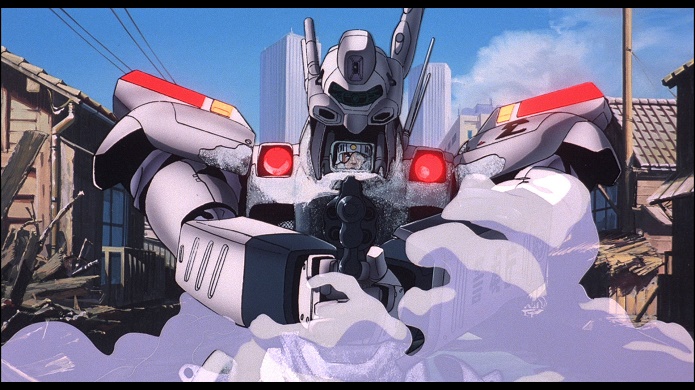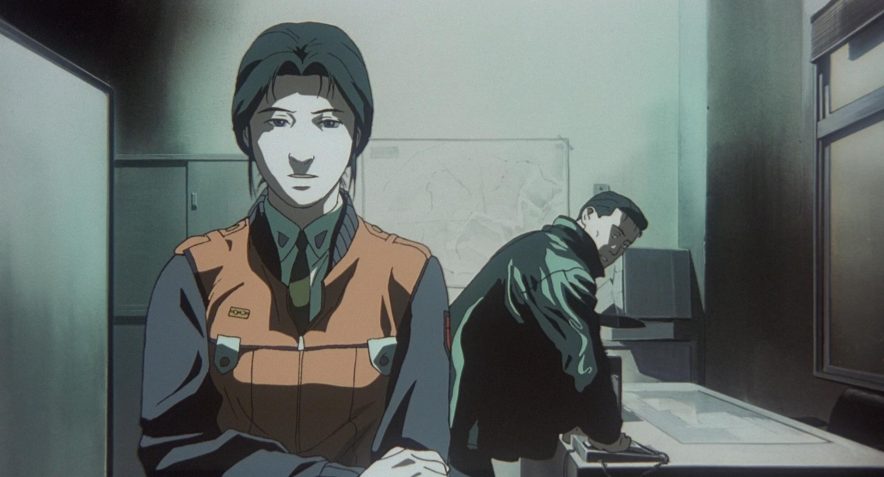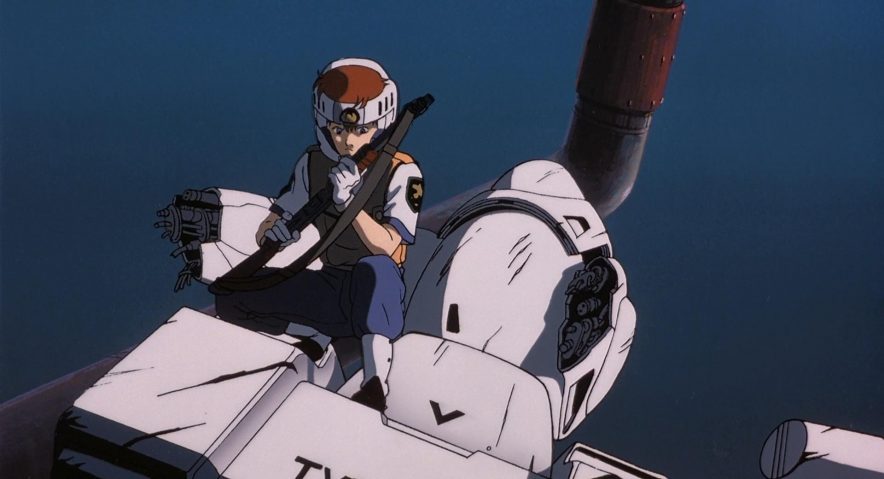Anime Review: The Patlabor Movies

 On occasions where I’ve been asked to describe Patlabor in the past, I’ve usually said something to the effect of “It involves a lot of people having conversations in the vicinity of mechs.” That oversimplification isn’t deliberately meant to be a slight, but it is fair to say story and dialogue is typically more front and centre than gratuitous action scenes in this franchise. While Patlabor spans a manga, OVA, a TV series, several feature films and more, my specific interest is in the three movies released between 1989 and 2002.
On occasions where I’ve been asked to describe Patlabor in the past, I’ve usually said something to the effect of “It involves a lot of people having conversations in the vicinity of mechs.” That oversimplification isn’t deliberately meant to be a slight, but it is fair to say story and dialogue is typically more front and centre than gratuitous action scenes in this franchise. While Patlabor spans a manga, OVA, a TV series, several feature films and more, my specific interest is in the three movies released between 1989 and 2002.
Set in the Greater Tokyo Area in the far flung future of the late 1990’s, Patlabor, a portmanteau of ‘patrol’ and ‘labor’, deals with members of the Tokyo Metropolitan Police’s Special Vehicles Section. Part mecha anime, part police procedural, this is a world where high tech robots called labors are a part of everyday life. The Special Vehicles Section utilize their own patrol labors to deal with incidents that involve rogue labors, crime, accidents or terrorist threats. While the focus is on the pilots and their support crew, senior commanders, maintenance staff and other police divisions all feature in the plot lines as well.
Headgear, the group responsible for the primary creation of Patlabor, and the movies and manga in particular, are each accomplished writers, artists or filmmakers. Names such as Masami Yuki, Yutaka Izubuchi, Kazunori Ito, Akemi Tamara and Mamorou Oshii are all heavy hitters in the industry, known to even a relative layman like myself. While the tone and pacing of the franchise, even across different formats, may not necessarily be to everyone’s liking, there is no denying the creative talents on display here. The animation is of a brilliant standard and the designs, particularly of the labors themselves, arguably iconic. Patlabor stands out in a fairly crowded mecha anima field.
My personal experience with mecha themed anime was limited to Detonator Orgun, Robotech and little else. I caught Patlabor: The Movie late one night, a few years after having played the PC game Shogo: Mobile Armor Division and was struck by some visual similarities. I later discovered this was no coincidence, as the makers of Shogo had cited Patlabor as a direct inspiration. Eventually I would see all three film releases in the franchise – I will give my impressions below:

Patlabor: The Movie (1989)
While the 7 episode OVA series, Mobile Police Patlabor/Early Days deals with the origins of the Special Vehicles Section (SVS) and serves as a good lead-up to this first film, it is by no means necessary to follow the plot. The backdrop is a rapidly re-developing Tokyo: old neighbourhoods are being demolished, skyscrapers arise, and newly reclaimed land in the bay expands the city ever further. Construction robots are critical to this expansion and Shinohara Heavy Industries, the chief labor supplier, manufacture them by the hundreds in their huge “Ark” island complex.
A key Shinohara employee who designed an advanced labor operating system, newly in use, jumps to his death into the bay. In the coming months, incidents of labors (including a deadly military variant) running amok are on the increase, and SVS under Captain Goto is overwhelmed responding to and investigating these issues. The mystery of why labors are going haywire and ignoring their pilot’s controls, seemingly at random, is found to be connected in some way to the dead OS programmer. In the course of the story, an imminent threat to Tokyo and the world at large is uncovered. Thanks to reticence from politicians, SVS are left largely on their own to fight it.
Though they spend much of the film standing in the wings, the labor designs, particularly the police “Ingram” model so well associated with the franchise, are fun to watch when they do join the action. Their policing theme is consistent both in terms of their looks and equipment, being armed with scale sized revolvers, shotguns, batons and riot shields. Combat is about as grounded as could be expected with these towering machines and collateral damage the norm. The sight of a labor pilot manually loading six giant shells into a massive cylinder during a pause in battle barely raised an eyebrow for me personally – the world-building and attention to detail in Patlabor is such that scenes like this just fit and feel right.
Pilot Noa Izumi, the main character across much of the franchise, and her commander in the field, Sgt. Asuma Shinohara (not a coincidental surname) are at the centre of much of the plot. Captain Goto is the laid-back leader of SVS Division 2, far more cagey and intuitive than his superiors apparently give him credit for. His Division 1 colleague Captain Shinobo Nagumo clearly understands his understated talent for policing, as does Detective Matsui, a respected contact in the Metropolitan Police. Other pilots (notably, trigger happy Isao Otha), technicians and politicians round out the cast.
The tone of the film shifts regularly between dramatic and comedic. In one moment the captain will be in the middle of a monologue about the mysterious antagonist’s twisted worldview and the symbolism in Tokyo’s “Babylon Project”; not long after you could expect to see a police car trod on by an over-eager Otha, or the mad-cap labor maintenance team enjoying a snack of tomatoes. The music is sparse in places, but tends to match the visuals well – of particular note is the moody, discomforting traditional music that follows two detectives as they investigate the shadowy programmer’s past around dilapidated corners of the city.
The voice acting is great, and the English Manga UK dub is littered with actors I fondly recognize from many other films and OVAs. No one performance particularly stands out, though neither is there any terrible, jarring acting that ruins the experience. I can’t speak to the Bandai Visual release that was re-dubbed years later, whether it is superior or even why it was recorded.
Despite a lot of exposition and the fact there are only a few extended action sequences in the film, there is a lot to like in Patlabor: The Movie. Anime of this era, of this quality are largely a thing of the past so I personally enjoy it for a mixture of nostalgic reasons and a genuine enjoyment of the story. If you can take a giant-robot premise with a touch of philosophy and near-future setting, this is definitely worth a try.
Patlabor 2: The Movie (1993)
This sequel is set several years after the events of the first movie. Much has changed for Special Vehicles Section. Asuma and Noa are now dedicated labor testers, Otha an over-bearing pilot instructor. Shinobu Nagumo is now effectively division chief for SVS but dependable Captain Goto remains in charge of Division 2, albeit with a vastly different crew.
With labors still as integral as ever to Tokyo’s unceasing development, SVS remains vigilant. When a missile hits the Yokohama Bay Bridge, an apparent act of terrorism, the city and all branches of government and law enforcement are caught off guard. Early indications are that a rogue element within the defence forces are involved. A mysterious agent reaches out to Captain Goto, hoping that SVS, with a reputation for being mavericks, can try to investigate the apparent culprits quietly. Exactly who is friend and foe isn’t entirely clear.
Needless to say, there is a lot of talking and politicking going on in Patlabor 2: The Movie and relatively sparse action. If you didn’t like this formula in the first film in the franchise, it is fair to conclude you won’t like it here either. Nevertheless, there is a lot to enjoy. The animation previously of a high standard, is at another level here, and though computer graphics are mixed in in places, the results are not distracting. The soundtrack is also a step up, and fits the more moody atmosphere of this second film to a tee. Quiet sequences with snow falling on Tokyo streets filled with deployed soldiers are poignant.
The motivations of this story’s antagonist are somewhat more obtuse than in the first Patlabor movie. Terror, or the threat of it, is used to manipulate the various government factions. Japan’s relationship post-war relationship with the US is a significant factor, and there is a fair amount of commentary on industry’s relationship with the military. A statement is being made, though with perhaps less clarity than the audience might require – particularly outside of the 1990s when this was first released. For a film with so much exposition, Patlabor 2 can get confusing if you miss key details.
The voice acting is as good as ever, with apparent continuity in existing characters and a few new familiar talents rounding out the new cast. Supporting characters like Detective Matsui also make their appearances, and there are lots of nods to the first film to notice. What action there is in the film is definitely fun and at least as enjoyable as it was in the previous outing. I can make a solid recommendation to fans of earlier work in the franchise, but this is really difficult to see a less invested viewer finding much enjoyment in beyond the visuals.

WXIII: Patlabor The Movie 3 (2002)
Though the third movie in this franchise, the events of Patlabor 3 actually take place between the other two films. I’ve read it described as a side-story, but given how disconnected it feels one wonders why it was set in the world of Patlabor at all. Science-fiction and horror themes are more pervasive than any of the concepts or story beats explored previously.
The plot centres on a pair of police detectives investigating strange attacks targeting labors. Something unnatural is happening and a secretive biological weapons program run by the military is connected. Disappointingly, neither of these detectives is the likeable Matsui featured in the prior films. This is really more of a monster/mystery than it is a mech themed anime – were it not for the eventual appearance of Special Vehicle Section late in the plot-line, you’ll be left wondering why the word Patlabor is even in the title. While there are a few familiar faces (though not voices, given an entirely new direction on the English dub) in a very brief section before the end of Patlabor 3, don’t expect any of the usual banter or philosophising.
Probably this film’s greatest sin, part from squandering almost the entire run time on a story than barely touches on anything that feels like Patlabor, is its inability to fit in the franchise in any meaningful way. Bio-engineered monsters belong in a different setting, in a different anime. If there was an enjoyable tale here worth seeing I might consider a mild recommendation but Patlabor 3 fails on every level.
Apologies for ending on a down-note, but rare is an anime franchise that sustains a level of quality indefinitely. Patlabor may have found renewed life in other OVAs and TV series but, for now, this is the movie selection, for better or worse. I’ll admit this property is an acquired taste but any fan of 90’s anime should give at least the first two films a chance.








Leave a Reply